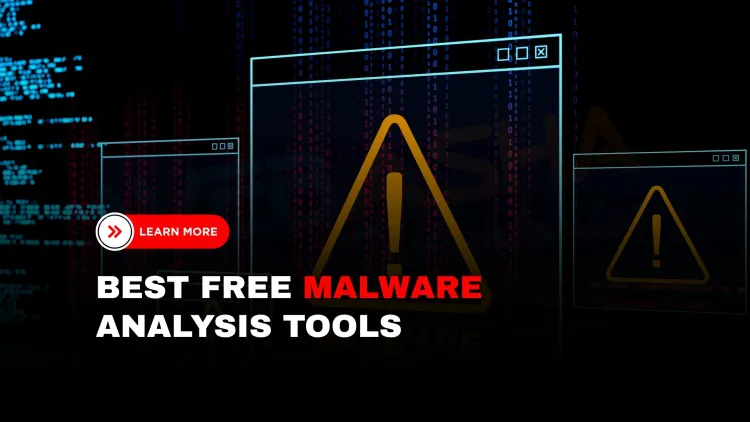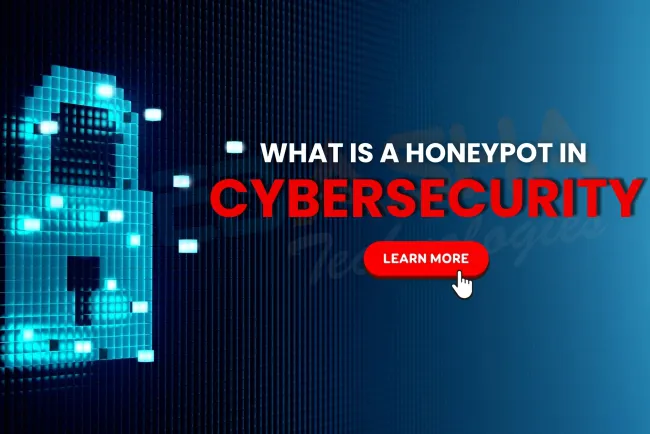What are the best free malware analysis tools in 2025 for reverse engineering and threat detection?
In 2025, malware threats are more advanced than ever, and malware analysis is a critical skill for cybersecurity professionals, SOC teams, and ethical hackers. Fortunately, many powerful tools are available for free to help dissect malicious files, observe behaviors, and identify indicators of compromise. This blog highlights the 10 best free malware analysis tools in 2025, including tools like Ghidra, YARA-X, Cuckoo Sandbox, ANY.RUN, and PEStudio. Whether you’re building a malware lab, investigating a suspicious sample, or just starting your journey in reverse engineering, these tools provide everything you need—at zero cost.

Keeping track of modern malware can feel overwhelming, but you don’t have to spend big money to start pulling malware apart and learning how it works. Below are ten completely free tools—some run in the cloud, others on your own lab PC—that security analysts, students, and hobbyists rely on in 2025. Each one helps you peek inside a suspicious file, watch what it does, and gather clues you can share with your team.
Why Free Malware‑Analysis Tools Matter
-
Lower the barrier to entry – anyone can start learning reverse engineering.
-
Quick triage – decide if a file is malicious before escalating.
-
Community support – open‑source projects grow fast thanks to shared plugins and rules.
-
No‑cost lab building – great for students, nonprofits, and under‑funded SOCs.
Quick‑Look Table
| Tool | What It Is | Best Use Case | 2025 Highlight |
|---|---|---|---|
| Ghidra | Full reverse‑engineering suite | Deep code digging | Version 11 adds AI‑assisted decompilation |
| YARA‑X | Rule‑based pattern matcher | Hunt similar samples | New Rust rewrite boosts speed |
| Cuckoo Sandbox | Automated detonation sandbox | Dynamic behavior reports | Updated modules for Windows 11 |
| ANY.RUN (free tier) | Interactive cloud sandbox | Click‑through malware flows | Real‑time process graphs & API |
| PEStudio | Portable static analyzer | Quick PE file triage | Flags risky APIs instantly |
| CyberChef | “Cyber Swiss‑Army Knife” in your browser | Decode / deobfuscate strings | New 2025 recipe library |
| REMnux | Linux distro packed with tools | All‑in‑one analysis VM | Version 2025.1 ships with Ghidra & Volatility pre‑installed |
| VirusTotal Community | Cloud multi‑AV scanner | Quick reputation checks | Live Sigma rule matches on uploads |
| FLARE VM | Windows‑based analysis lab | Install on a spare laptop | 2025 script auto‑installs 80+ RE tools |
| CAPE Sandbox | Community Advanced Platform Emulator | Extracts payloads & configs | Adds Python 3 plug‑in framework |
Ghidra
An open‑source reverse‑engineering powerhouse created by the NSA. It disassembles, decompiles, and debugs Windows, Linux, macOS, and even embedded firmware files. The 2025 release (v 11.x) adds optional AI hints that suggest function names and spot common crypto routines. Great for anyone who wants to read a malware author’s code line by line.
YARA‑X
The classic YARA engine got a full Rust makeover in 2025—now called YARA‑X. It’s lightning‑fast and still free. Write simple rules like strings: $a = "evil.com" or build complex Boolean logic to hunt entire malware families inside folders, memory, or even Cuckoo reports.
Cuckoo Sandbox
Spin up a disposable virtual machine, drop a suspicious document, and watch what happens. Cuckoo logs API calls, network traffic, screenshots, and dropped files. The latest community build supports Windows 11 guests and ships Docker images for quick lab setup.
ANY.RUN (Community Edition)
A cloud‑based, interactive sandbox: you can click buttons, enable macros, or plug in USB drives inside a live VM while telemetry streams in. Perfect for ransomware that waits for user action. A free tier lets you run short analyses and share public links with peers.
PEStudio
Drag‑and‑drop a Windows executable and instantly see imported functions, suspicious strings, entropy scores, and VT verdicts—all without running the file. A must‑have for first‑glance triage on any analyst’s desktop.
CyberChef
Open your browser, paste encoded or obfuscated blobs, and stack operations like “From Base64 → Inflate → Beautify” until readable code appears. Recipes are shareable, and 2025 added a community gallery for one‑click decoding workflows.
REMnux
A security‑focused Ubuntu spin with hundreds of malware‑analysis tools pre‑installed. Boot it in VirtualBox or as a live USB to get Ghidra, Volatility, Radare2, and more in one shot. New snapshot scripts help roll back your lab to a clean state after messy tests.
VirusTotal Community
Upload a sample (or just its hash) and VirusTotal scans it with 70+ antivirus engines, shows static metadata, and suggests similar files. The free API lets you automate bulk queries—great for quickly confirming if a sample is brand‑new or well‑known.
FLARE VM
A Windows‑based toolkit from Mandiant. Run a single PowerShell script and your VM installs debuggers, decompilers, Python packages, and useful PowerToys. It’s an easy way to build a personal RE lab while still being able to test malware that needs a Windows GUI.
CAPE Sandbox
CAPE (Community Advanced Platform Emulator) extends Cuckoo with automatic unpacking: it extracts embedded configs, dropped binaries, and decrypted shellcode. Analysts love its rich JSON reports and the new Python 3 plug‑in system for custom detectors.
Final Tips for New Malware Analysts
-
Use multiple tools together—static + dynamic views give the best picture.
-
Keep your lab isolated (snapshots, VLANs, or offline VMs).
-
Share YARA‑X rules or CyberChef recipes with the community; collaboration speeds learning.
-
Document every finding; even small strings can link separate malware campaigns.
With these ten free resources, breaking down malware samples in 2025 is more accessible than ever. Happy hunting—and stay safe!
FAQs
What is malware analysis?
Malware analysis is the process of studying malicious software to understand how it works, what it does, and how to defend against it.
Why is malware analysis important in 2025?
Because threats are more advanced and stealthy, malware analysis helps uncover hidden behaviors, payloads, and indicators of compromise (IOCs).
Are there free tools available for malware analysis?
Yes, many powerful malware analysis tools like Ghidra, YARA-X, and Cuckoo Sandbox are available for free.
What is Ghidra used for in malware analysis?
Ghidra is a reverse engineering tool used to analyze binaries, decompile code, and explore malware internals.
How does Cuckoo Sandbox work?
Cuckoo runs malware in a virtual environment and logs its behavior, such as file modifications, registry changes, and network activity.
What is YARA-X and how is it different from classic YARA?
YARA-X is a faster, rewritten version of YARA in Rust, designed for improved performance and rule matching.
What can ANY.RUN do for malware analysis?
ANY.RUN is an interactive online sandbox that lets you manually explore malware behavior in real-time.
Is PEStudio safe to use?
Yes, PEStudio is a static analysis tool that analyzes executables without executing them.
What is CyberChef used for?
CyberChef is a browser-based tool for decoding, encoding, and transforming data — great for analyzing obfuscated malware strings.
What is REMnux?
REMnux is a Linux distribution packed with malware analysis and reverse engineering tools.
Can VirusTotal be used for malware analysis?
Yes, it scans files using 70+ antivirus engines and shows detection results and metadata.
Is FLARE VM good for beginners?
Yes, FLARE VM sets up a Windows-based reverse engineering lab with essential tools installed.
What is CAPE Sandbox?
CAPE extends Cuckoo by extracting configs, payloads, and shellcode automatically during analysis.
Which tools are best for static analysis?
PEStudio, Ghidra, and CyberChef are ideal for static malware analysis.
Which tools are best for dynamic analysis?
Cuckoo Sandbox, ANY.RUN, and CAPE Sandbox specialize in dynamic behavior tracking.
Do I need a virtual machine for malware analysis?
Yes, using VMs like REMnux or FLARE VM helps isolate malware and avoid infecting your host system.
Are these tools legal to use?
Yes, these tools are legal to use for educational, research, or professional cybersecurity purposes.
Can I run malware analysis on Windows?
Yes, tools like FLARE VM and PEStudio run on Windows systems.
Is Linux required for malware analysis?
No, but tools like REMnux offer more flexibility for network and memory analysis on Linux.
What kind of malware can these tools detect?
These tools can analyze trojans, ransomware, worms, rootkits, stealers, droppers, and more.
What is a sandbox in malware analysis?
A sandbox is an isolated environment where malware can be safely executed and observed.
Do I need coding skills to use these tools?
Basic scripting knowledge helps, but tools like ANY.RUN and CyberChef are beginner-friendly.
Can students use these tools?
Absolutely. These tools are great for learning malware analysis and reverse engineering.
What file types can be analyzed?
You can analyze EXE, DLL, DOC, PDF, JS, BAT, and even raw binary files.
Are these tools suitable for enterprise use?
Yes, many enterprises use free tools alongside commercial ones for deeper insights.
Can these tools be used for threat hunting?
Yes, YARA-X and VirusTotal help in detecting and hunting malware variants.
How do I safely collect malware samples?
Always use a VM, disable internet access, and source samples from trusted malware databases like MalwareBazaar or VirusTotal.
Can these tools detect zero-day malware?
Some can reveal suspicious behavior, but dedicated zero-day detection requires advanced techniques.
How do I get started with malware analysis?
Set up a VM (like REMnux or FLARE VM), download tools like Ghidra, and practice on harmless samples.
Is there community support for these tools?
Yes, there are active communities on GitHub, Reddit, and Discord focused on malware analysis and sharing knowledge.














![Top 10 Ethical Hackers in the World [2025]](https://www.webasha.com/blog/uploads/images/202408/image_100x75_66c2f983c207b.webp)








